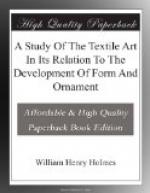In color, as in relieved design, each species of constructive combination gives rise to more or less distinct groups of decorative results, which often become the distinguishing characteristics of the work of different peoples and the progenitors of long lines of distinctions in national decorative conceptions.
In addition to this apparently limitless capacity for expression, lovers of textile illumination have the whole series of extraordinary resources furnished by expedients not essential to ordinary construction, the character and scope of which have been dwelt upon to some extent in the preceding section.
I have already spoken of color in a general way, as to its necessary presence in art, its artificial application to fabrics and fabric materials, its symbolic characters, and its importance to esthetic progress. My object in this section is to indicate the part it takes in textile design, its methods of expression, the processes by which it advances in elaboration, and the part it takes in all geometric decoration.
It will be necessary, in the first place, to examine briefly the normal tendencies of color combination while still under the direct domination of constructive elaboration. In the way of illustration, let us take first a series of filaments, say in the natural color of the material, and pass through them in the simplest interlaced style a second series having a distinct color. A very simple geometric pattern is produced, as shown in Fig. 315. It is a sort of checker, an emphasized presentation of the relievo pattern shown in Fig. 291, the figures running horizontally, vertically, and diagonally. Had these filaments been accidentally associated in construction, the results might have been the same, but it is unnecessary to indicate in detail the possibilities of adventitious color combinations. So far as they exhibit system at all it is identical with the relievo elaboration.
[Illustration: Fig. 315. Pattern produced by interlacing strands of different colors.]
[Illustration: Fig. 316. Pattern produced by modifying the alternation of fillets.]
[Illustration: Fig. 317. Isolated figures produced by modifying the order of intersection.]
Assuming that the idea of developing these figures into something more elaborate and striking is already conceived, let us study the processes and tendencies of growth. A very slight degree of ingenuity will enable the workman to vary the relation of the parts, producing a succession of results such, perhaps, as indicated in Fig. 316. In this example we have rows of isolated squares in white which may be turned hither and thither at pleasure, within certain angles, but they result in nothing more than monotonous successions of squares.
[Illustration: Fig. 318. Pattern produced by simple alternations of light and dark fillets. Basketry of the Indians of British Guiana.]




